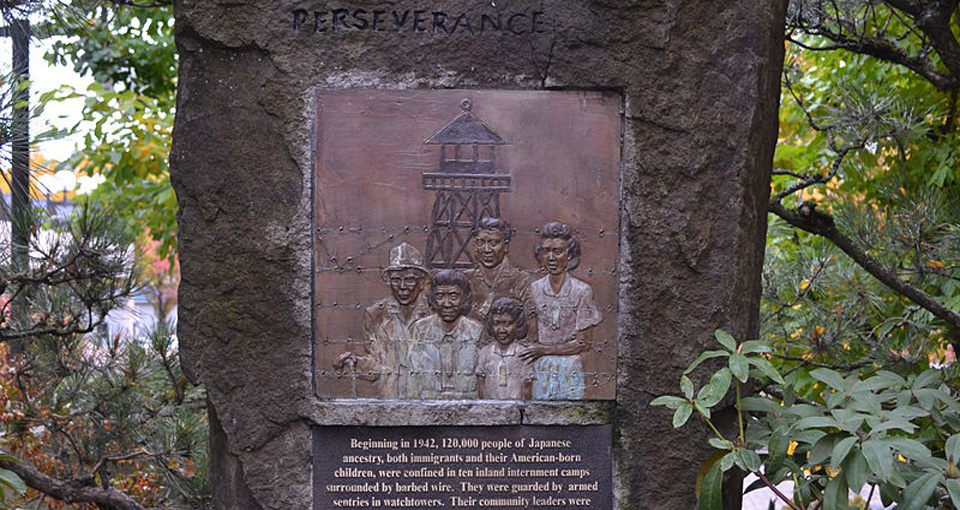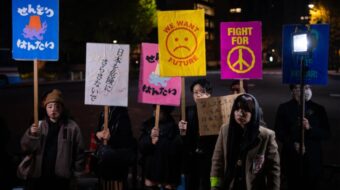
The following article about this important anniversary was printed by peoplesworld.org on the anniversary of the attack on Pearl Harbor two years ago. It remains relevant as we remember the attack and also the horrific internment of Japanese Americans that followed it. – Editors
This week marks the 75th anniversary of the early morning December 7, 1941, Japanese attack on the U.S. naval base at Pearl Harbor on the island of Oahu, Hawaii. In his speech given before a joint session of Congress the following day, President Franklin D. Roosevelt called it “a day which will live in infamy” and declared war on Japan. The U.S. entered the war against Nazi German and fascist Italy on December 11th.
More than 350 Imperial Japanese fighter, bomber and torpedo planes attacked in two waves, launched from six Japanese aircraft carriers. Eight U.S. Navy battleships were damaged, and four sunk. The attacks also sank or damaged three cruisers, three destroyers, an anti-aircraft training ship and a minelayer, with 188 U.S. aircraft destroyed. Americans killed numbered 2403, and 1178 others were wounded.
Remaining military survivors of the attack would now all be well into their nineties.
Tension with Japan had escalated since the Japanese invasion of Manchuria, a large northern province of China, in 1931. The U.S. and other Western powers lent support to the Republic of China, although the U.S. did not cut off oil exports to Japan, ceasing only in July 1941 after the Japanese occupied French Indochina. The American left is remembered during those years as having forcefully advocated boycotting Japanese goods, such as silk stockings, and also for demanding that U.S. corporations stop selling scrap metal to Japan, which the Japanese were processing into war matériel.
Interpretations of U.S. unpreparedness for the attack vary. According to some widely held conspiracy theories, the U.S. was aware of the plans but allowed the attack to happen in order to force the U.S. into war. Generally, officials expressed surprise that Japan had not first attacked the Philippines—then still a U.S. possession—which was much closer than Hawaii.
On February 19, 1942, Pres. Roosevelt signed Executive Order 9066 affecting Japanese Americans, ostensibly out of military necessity but with no supporting evidence for it. About 80,000 native-born U.S. citizens, along with another 40,000 foreign-born citizens, were forced to register and assemble at centers from which they would be transported to internment camps scattered in rural areas through the Western states. Their homes, farms, businesses and property had to be abandoned.
Men of draft age were severely torn between resentment that their government was acting in such a biased way against their community and a desire to prove their patriotism by enlisting. Men who served were sent to the European theater and distinguished themselves by their valor. At home, few civic organizations defended the Japanese Americans. The Communist Party supported the government position at that time. A leading exception was the American Civil Liberties Union, which challenged the order before the Supreme Court. Although the Court sided with the government, some justices dissented. Justice Robert Jackson objected to the military order reasoning that “the principle then lies about like a loaded weapon, ready for the hand of any authority that can bring forward a plausible claim of an urgent need.”
Already some voices around President-elect Donald Trump are citing the Japanese American registry and internment as a model for treating Muslim Americans today. And for years now, since the beginning of the Iraq and Afghanistan wars, “military” prisoners at the U.S. base at Guantánamo have been detained indefinitely without benefit of trial or due process in direct conflict with U.S. law.
“I grew up behind U.S. barbed wire fences,” recalls one survivor, the well known actor George Takei. He recently wrote and starred in a Broadway musical, Allegiance, about the divisive effects internment had on his and other Japanese American families. Takei is also a founder of the Japanese American National Museum in the Little Tokyo district of downtown Los Angeles.
Eventually, America came to see the error of Order 9066, and issued formal apologies and small reparations to internment camp survivors. The Civil Liberties Act of 1988, signed by Pres. Ronald Reagan, admitted that the original order was inspired by “race prejudice, war hysteria and a failure of political leadership.” Tule Lake and Manzanar in California, sites of Japanese American segregation centers during World War II, have been designated as national parks in order to educate fellow Americans about this dark phase of our history.
Sources include Wikipedia and Westways magazine.










